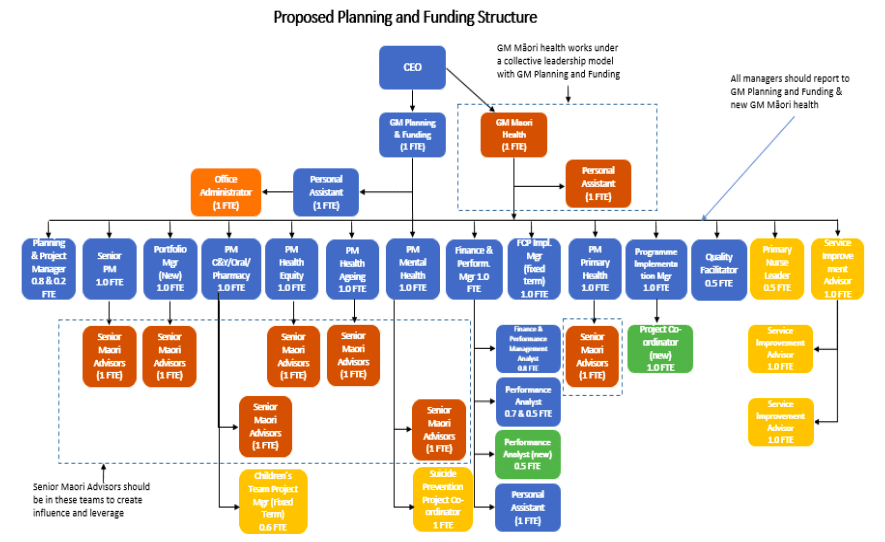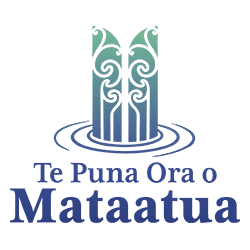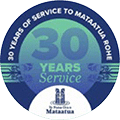1.0 Executive summary
1.1 Response on consultation process
1. Te Puna Ora o Mataatua Charitable Trust (the Trust) is disappointed in the consultation process with Māori. The consultation process has been inadequate with no notice of the presentation of the proposal and with only one week to make submissions;
2. The Trust notes the principles of the Treaty of Waitangi are absent¬—both in the process and the substance of what is being proposed. Key principles of rangatiratanga (partnership) and taonga (health and well-being) provide a longstanding framework to develop strategic and institutional proposals.
3. The Trust is disappointed that they have not seen or been provided with a copy of the final report drafted by EY Tahi that briefly engaged Māori providers in 2016;
4. The Trust noted that the “Good to Great Programme” requires input and consultation from Māori Health Providers if it is going to be successful in reducing health disparities in the region;
5. The Trust acknowledges the health statistics reflecting poor health outcomes for Māori in the Bay of Plenty region and agree that change is needed. However, we believe that change should be a whole system approach and not solely within the Māori Planning and Funding team or solely within the DHB.
1.2 Response on proposal
6. Overall the Trust agrees in principle to the following:
• The creation of a new DHB wide role of General Manager Māori Health—creating better effectiveness and efficiencies;
• Building a unit with strong connections between the work and activity of the Māori Health Planning and Funding (MHPF) and Regional Māori Health Services (RMHS);
• There needs to be a shift from building Kaupapa Māori provider capacity and capability to closing the disparity gap and improving mainstream responsiveness to Māori health and well-being (influencing the 96.5% of funding);
• There is no reduction in resource in the Māori Health Space.
7. The Trust does not agree with the following:
• With proposals 2A and 2B.
• With meeting strategic organisational priorities including the “Good to Great Programme” and any other related strategic and organisational plans;
• That “Trendly” is an accurate measuring and evaluation tool for Māori health and well-being;
• With Appendix 3: Proposed Organisational Structure for the Planning and Funding Team—infrastructure, resources and reporting lines isolated from Māori Health Planning and Funding Team;
• With Appendix 4: Proposed Organisational Structure for the Māori Health Planning and Funding Team— infrastructure, resources and reporting lines isolated from Planning and Funding Team;
8. The Trust Proposes the following:
• Amend Aim 2: elevating and strengthening the executive leadership of Māori Health, through the GM Māori Health, and include the words, “across the whole organisational structure of BOPDHB”;
• That the GM Māori Health, on behalf of the CEO, regularly reports to the Rūnanga.
• That any new strategic and organisational priority programmes be developed by the new incoming General Manager Māori Health including a meaningful consultation process with Māori providers;
• That any new strategic and organisational priority programmes consider Eastern and Western sub-strategies given the different profiles of the communities;
• That any new strategic and organisational priority programmes include the development of new evaluation and measuring tools that accurately captures Māori health and well-being data;
• That a unified and integrated model of healthcare requires a unified and integrated organisational model;
• An amended organisational structure for consideration.
2.0 Introduction
2.1 About Te Puna Ora O Mātaatua Charitable Trust (the Trust)
9. The Trust has been providing health and well-being services across the Mātaatua rohe since 1991. Based in Whakatane, the Trust currently serves over 3000 clients in the Eastern Bay of Plenty. The Trusts services include:
• Med Central General Practice (jointly owned with Poutiri Trust)
• Home Based Support Services
• Whānau Ora Health Promotion
• Mama & Pepi Service
• Koroua and Kuia Service
• Whānau Ora Kaiarahi
• Oranga Tamariki (Vulnerable Children)
• Social Housing
• Waka Rangatahi (Driving Academy)
• Research Institute
2.2 Māori health disparity
10. Life expectancy for Māori males is eight years less than that of non-Māori males. For Māori women the disparity is 7.6 years. Māori have higher rates of exposure to many risk factors such as tobacco use, exposure to second-hand smoke, and hazardous alcohol use. Although Māori have similar levels of exercise and vegetable consumption as the non-Māori population, Māori are more likely to be overweight or obese, to be admitted to hospital for avoidable causes, and to die at a younger age.
11. Māori have higher rates of unmet needs for primary care services (statistically significant for Māori females), have lower levels of enrolment in Primary Health Organisations (PHOs), lower rates of oral health care consultations, and live in areas where there are fewer General Practitioners (GPs) per capita. Lack of fluoridation in water supplies leads to poorer dental outcomes in Māori children compared with non-Māori children.
12. Since 1975, Māori rates of mental illness have increased, while the rates for Māori for a number of primary health problems such as heart disease and infant mortality rates have declined. Māori, for a range of reasons, have a different profile to non-Māori as far as mental illness is concerned. Late referral for treatment is a significant reason for higher levels being recorded. Since 38 percent of Māori referrals come from law enforcement or welfare services primary, early intervention and mental health services need to be more accessible and appropriate to the needs of Māori to reduce entry of Māori in crisis and emergency circumstances.
13. Addressing these inequities, remain major public policy challenges facing governments whom are simultaneously attempting to achieve a plethora of other priority policies from their respective political agendas. The challenge of resolving ethnic inequities is complicated by the historic and ongoing role of the state in both generating and perpetuating ethnic inequities through their policies and practices.
3.0 Rationale for disagreement:
3.1 Proposals 2A and 2B
14. The mainstream health allocates and controls 96.5% of the resource to mainstream health. Proposal 2A and 2B proposes a shift of resource from the Māori Health Planning and Funding team to the mainstream Planning and Funding team. The suggestion that this will improve mainstream responsiveness to Māori is not supported by evidence. Despite controlling 96.5% of the resources, the DHB has made a statement to Māori that it wants to bring the Māori Health resource under its Mainstream leadership. This will further diminish the resource allocated to Māori and denies Māori the ability to apply their own solutions to improve Maori health.
15. It is the Trust view that Proposal 2A and 2B is fundamentally flawed. Without Maori leadership at the executive level in the Planning and Funding team delivering targets based on Māori strategies and priorities, there will be no impact on Māori health outcomes or the responsiveness to Māori.
16. What is even more concerning is the perceived “mainstreaming” agenda. The premise of the proposals is that Māori cannot achieve better outcomes for Māori unless positioned under a mainstream model as the aim of the proposal states that “refocusing TTHW resources to support service improvement will accelerate the reduction of Māori disparities by increasing our focus on collective responsibility”. History tells us that where Māori are not included in decision making at the executive level that Māori strategies and priorities are put aside to make way for the dominant mainstream priorities.
17. The Trust does not believe it is reasonable to expect that the shift of resource will achieve the following as described in the document on page 3:
• Enhance mainstream responsiveness to Māori;
• Accelerate a reduction of Māori Health Disparities; and
• Enhance change management capability.
18. Structurally the proposal reinforces the power imbalances between mainstream funding and Māori funding within the BOPDHB.
3.2 “Good to Great Programme” and other related strategic and organisational plans
19. The “Good to Great’ Māori Health programme was about “building relationships with Iwi and Maori communities” however the programme lacks consultation and input from Māori health providers. The Trust view is that any Māori health programme must be designed for the whole system including Māori health providers. Lack of consultation has led to an ineffective and an inefficient strategy being carried out. Any strategic and organisational plans for Māori requires input from all Māori.
3.3 “Trendly” measuring and evaluation tool for Māori health and well-being
20. It is important to recognise Trendly is a tool and must be deployed within a broader vision for Māori Health where Māori Rangatiratanga is fundamental to the strategy. The issue with Trendly is that the Māori community do not have the ability to validate these results or work with the data in a meaningful way to improve the outcomes for Māori. Moreover, its focus is narrow and fragmented from other parts of healthcare. As a tool, it goes not recognise or support a whānau ora approach to healthcare.
21. The Trust finds it more useful to use a results based accountability (RBA) and measurement framework to collect and report on client outcomes. Under RBA the Trust evaluates the results of their programmes using their understanding of the communities to determine, how the communities, whānau and clients are better off as a result of the services delivered. The Trust is best placed to know what works in their communities, and to be effective under service contracts they need to concentrate on that as opposed to rigid guidelines measured by an evaluation framework like “Trendly”. The Trust is working toward the same goal – better outcomes for Māori families and communities. Therefore, they need to work with the BOPDHB on a improving the evaluation framework that reflect those goals.
22. A Māori well-being framework was developed by Māori researchers (Durie, Fitzgerald, Kingi, McKinley & Stevenson, 2002) for Māori-specific indicators of health and wellbeing. This utilises a holistic approach to health, wellbeing and development. This framework places value on producing outcomes and indicators which are consistent with Māori perspectives, processes and priorities.
23. Unless Māori development is closely aligned with Māori views and aspirations, then it might be analysed within frameworks that ultimately disadvantage Māori people. Māori development could be similarly undermined if a narrow developmental model, at odds with Māori worldviews, were allowed to signpost the direction ahead.
3.4 Proposed Structure for Planning and Funding
24. The proposed structure for planning and funding as documented on page 12 notes that none of the mainstream positions are affected. Conversely every staff member in the Māori Health Planning and Funding unit is affected. Although technically there is no reduction of the staff, there is a significant loss of influence at the executive level for Māori as the Māori Health Planning and Funding team is being stripped of its resources.
25. The GM Māori Health should be positioned within this unit at the same level as the GM Planning and Funding under a collective leadership model. All managers should report to the GM Planning and Funding and the new GM Māori.
26. There needs to be Māori advisors positioned in each team to create influence and leverage within the BOPDHB for Māori. This is additional to the service improvement roles proposed for the Māori Health staff. These positions should have Key Performance Indicators (KPI’s) guided by a statement of expectations that reflects General Manager of Māori priorities. This level of consistent review ensures delivery of Māori Health priorities across the BOPDHB.
3.5 Proposed Structure for Māori Health Planning and Funding Team
27. We do not support the disestablishment of 4 FTE Māori Health Portfolio Manager roles as this will have an adverse impact on:
• Māori Provider capacity and capability development;
• Māori Provider relationship management;
• Māori Health Funding;
• Māori Health innovation, such as initiatives like Māori Health Excellence Seminars, He Pou Oranga, He Ritenga, Whanau Ora strategic framework;
• Commissioning and contracting;
• Strategic/Annual Planning with Māori communities and stakeholders;
• System change management with an equity lens; and
• Māori workforce development.
28. The restructuring proposal fails to recognise Māori aspirations and assertions for self- determination and Māori applying their own solutions to improve Māori health. Furthermore the General Manager of Māori Health still remains separate from mainstream. The influence on the 96.5% funding is only through the CEO which is the existing model and is already failing.
4.0 Rationale for proposal:
4.1 Elevating and strengthening the executive leadership of Māori Health
29. The Trust proposes elevating and strengthening the executive leadership of Māori Health, through the GM Māori Health, “across the whole organisational structure of BOPDHB”. The Trust proposes a “collective leadership” approach. This new form of leadership is required to enable the GM Māori Health to effectively influence the 96.5% funding for mainstream. Traditionally Māori health challenges cannot be tackled by an individual, or siloed department in the BOPDHB. However, a collective leadership group can be formed providing an organisational structure to achieve this goal. This would mean the GM of Māori Health would sit alongside the GM of Planning and Funding, with both GM’s reporting directly to the CEO. The managers in the planning in funding department would also report directly to both GM’s.
4.2 GM Māori Health, on behalf of the CEO, regularly reports to the Rūnanga
30. It is important that Māori health providers are consulted on all issues, initiatives, strategies and priorities that relate to Māori. This should be a primary role for the new GM Māori Health to build these relationships and facilitate a working relationship between the BOPDHB, Māori Health Runanga and Māori Health Providers. This process will give the GM of Māori Health the mandate to effect change within the BOPDHB using a collective Māori voice.
31. Māori health providers want to engage with the BOPDHB then implement this advice in a timely fashion. They seek to develop a mechanism for ensuring equitable representation of groupings of public health providers on steering and/or advisory groups. In addition the Māori health providers seek to ensure decision-making processes within the BOPDHB are sophisticated enough to be structurally inclusive of minority perspectives and not exclusive of Māori or their “Rangatiratanga”.
32. It is important moving forward that there is regular and formal dialogue with the Māori Provider network to strengthen the relationship between providers and DHB executive leadership to better understand each other’s issues and aspirations. The new GM Māori Health is pivotal to ensuring this occurs. However the effectiveness of effect change will depend on the resources allocated to the GM Māori Health and the position within the BOPDHB.
4.3 Strategic and organisational priorities
33. The “Good to Great’ Māori Health programme was developed in house by BOPDHB. Māori health providers need to be consulted and have input into all strategies and priorities. All General Managers must then have KPIs to reflect the strategies and priorities for Māori health. This is the only way they can be successful in influencing the 96.5% of funding and supporting mainstream services and providers to be more responsive to Māori Health gain.
34. The first milestone for the new General Manager of Māori Health is to achieve ownership of resources, unity within the Māori Health sector and improved relationships e.g. Te Mātawai (Māori Language Sector Restructure) process. This will start with genuine consultation on strategy and policies with Māori Providers.
4.4 Eastern and Western sub-strategies
35. Overall, Māori make up 50% (compared to 25% in the BOP) of the population in the Eastern Bay of Plenty (EBOP) territorial authorities – Whakatāne, Kawerau and Ōpōtiki. The Māori population has a much younger age structure than non-Māori in EBOP, and are more likely to live rurally and occupy the highest social deprivation deciles (9-10). With this situation Māori in the EBOP have significantly different needs relating to the demographics and outcomes in the region.
36. Therefore EBOP and Western Bay of Plenty (WBOP) require a subset of strategic and organisational priority programmes to address the different needs of these communities.
4.5 New evaluation and measuring tools
37. The Trust proposes that any new strategic and organisational priority programmes include the development of new evaluation and measuring tools that accurately captures Māori health and well-being data. This would include consultation with Māori Health Providers to determine the best evaluation framework, and how results will be recorded and reported. This would allow the Māori community to verify the accuracy and validity of the information and statistic. They could then work within their networks and together with the DHB to improve these outcomes using these results as a widely accepted marker of Māori Health outcomes.
4.6 Unified and integrated model of healthcare
38. The Trust proposes that a unified and integrated model of healthcare requires a unified and integrated organisational model. This means that Māori strategic plans and priorities are reflected in all GMs KPIs across the BOPDHB.
39. All teams in each department of the BOPDHB should have a Māori advisor to ensure that the values and principles of Māori Health along with Māori Health strategies and priorities are being applied and carried out at all levels and within all departments. Unification and integration would be at all levels. This means that at an executive level the GM of Māori Health would have the same influence on the 96.5% of funding. This can be achieved under a collective leadership model where departments report not only to the GM of Planning and Funding but to the GM of Māori Health also.
4.7 An amended organisational structure for consideration
40. See below the proposed amended organisational structure for consideration based on the principle of partnership:
a) The Planning and Funding Team reports to both the GM Planning and Funding and the GM Māori Health, with clear delegated responsibilities—providing line of sight, influence and integration;
b) The Planning and Funding Team Portfolio Managers have letters of expectations and KPIs that reflect Māori priorities and respectively report to GM Māori Health;
c) The Māori Health Planning and Funding Team continue reporting to the GM Māori Health but be allocated across the organisational structure as follows:
i. Managing the 3.5% funding allocation for Māori in building capacity and capability as well as supporting strategic interventions; and
ii. Positioned in key portfolio areas across the Planning and Funding Team to build policy and operational influence and integration.






